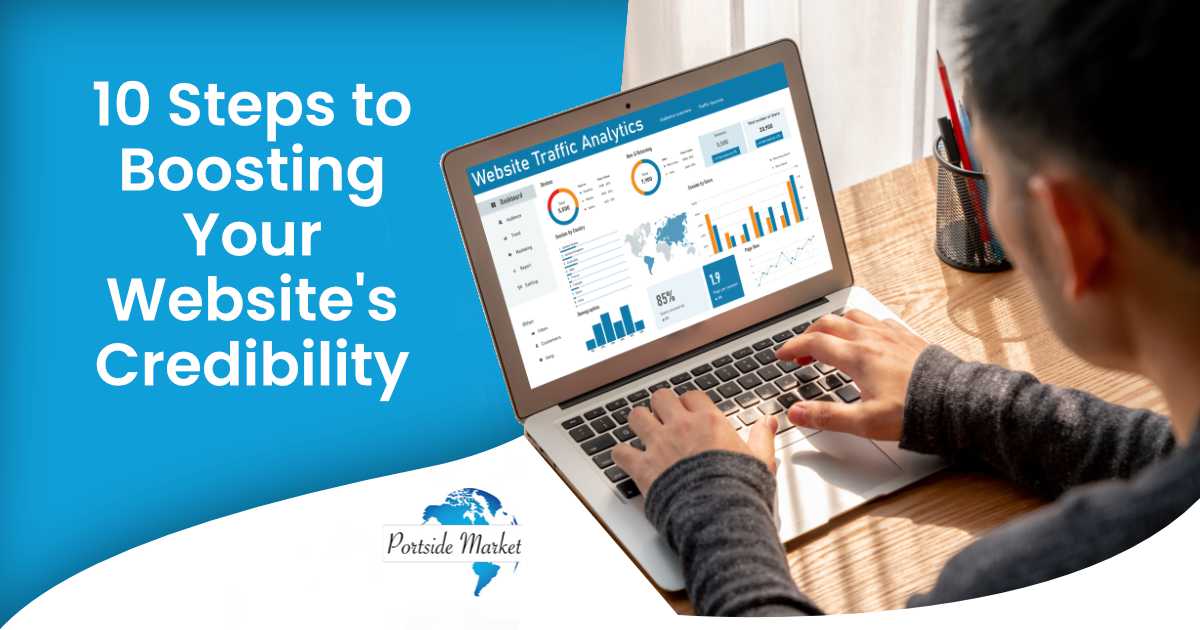Building website credibility is crucial for small and medium-sized businesses seeking to establish trust with potential customers. A credible website not only supports stronger brand reputation but also improves user confidence and drives higher conversions. Visitors are more likely to stay, engage, and purchase from businesses that present themselves as trustworthy online. By focusing on credibility factors, businesses can enhance their online presence, decrease bounce rates, and foster long-term growth opportunities.
Why Website Credibility Matters for Business Success
Website credibility has a direct impact on how users perceive a business. When visitors trust a site, they are more willing to share information, make purchases, and recommend the brand to others. On the other hand, a lack of trust signals—such as outdated design, missing contact information, or poor security—can quickly discourage potential customers.
- Trust and Conversions: A professional and credible website encourages users to complete actions such as filling out forms, booking consultations, or making online purchases.
- Customer Loyalty: When users feel confident in a business’s online presence, they are more likely to return and remain long-term customers.
- Brand Reputation: A website that reflects credibility strengthens the overall brand image and positions the business as a reliable entity in its industry.
Website credibility is no longer optional—it is a critical factor that affects visibility, customer relationships, and long-term success.
Step 1: Professional Website Design Builds Trust
A professional website design is the foundation of website credibility. Visitors often judge a business within seconds of landing on a site, and design quality plays a major role in shaping that first impression. A clean, organized layout with intuitive navigation communicates reliability and professionalism, while a cluttered or outdated design can undermine trust immediately.
Mobile-friendly design is also essential for credibility. Since many users browse on smartphones and tablets, a responsive website ensures consistent performance across devices. When visitors can easily navigate and interact with a site, it reinforces confidence in the business behind it.
Elements that improve website credibility through design include:
- Clear and simple navigation menus
- Consistent use of brand colors, fonts, and imagery
- Professional graphics and high-quality images
- Minimal distractions such as excessive pop-ups or ads
By investing in professional website design, businesses create a strong visual foundation that communicates trust and encourages visitors to engage further.
Step 2: Secure Your Site with HTTPS for Better Website Credibility
Website security is a key factor in building website credibility. An unsecured site signals risk, which can cause visitors to leave before exploring further. Adding an SSL certificate and enabling HTTPS shows users that the site protects their data and personal information.
Search engines also value site security. Google and other search platforms prioritize secure websites in search rankings, meaning HTTPS not only supports credibility but also improves online visibility. For e-commerce businesses, secure checkout pages are essential for customer trust and compliance with payment standards.
Businesses should display the padlock symbol in the browser bar and ensure all site pages are properly secured. This small step has a significant impact on website credibility by ensuring users that their information is safe.
Step 3: Showcase Authentic Testimonials and Reviews to Strengthen Website Credibility
Customer feedback plays a critical role in credibility. Authentic testimonials and verified reviews provide potential customers with real-world evidence that a business delivers on its promises. Displaying these reviews strategically across the website helps build confidence and reduces hesitation in the decision-making process.
Website credibility is strengthened when reviews include specific details, names, or even photos. Third-party review platforms such as Google Business Profile, Yelp, or industry-specific directories also reinforce authenticity.
Best practices for using testimonials and reviews include:
- Featuring customer feedback on product or service pages
- Including video testimonials when possible
- Highlighting case studies or success stories alongside reviews
- Responding professionally to both positive and negative feedback
Showcasing authentic testimonials not only supports website credibility but also demonstrates transparency, which helps businesses stand out in competitive markets.
Step 4: Provide Clear Contact Information to Enhance Credibility
Transparency is a cornerstone of website credibility. Visitors want to know that a business is legitimate and accessible. A website that clearly displays contact information helps establish trust and reassures users they can reach out if needed.
At a minimum, businesses should include:
- A phone number and professional email address
- A physical business address
- A contact form for inquiries
Placing contact details in the header, footer, or a dedicated “Contact Us” page makes them easy to find. For local businesses, integrating a map or directions further enhances credibility by showing a real, established presence. When customers see that a business is open and reachable, they are more likely to engage and complete transactions.
Step 5: Use High-Quality Content to Improve Website Credibility
Content is one of the most important factors in building and maintaining website credibility. Visitors rely on accurate, useful, and up-to-date information to evaluate whether a business is trustworthy. Poorly written, outdated, or duplicated content can damage credibility and drive potential customers away.
High-quality content should be:
- Well-researched and factually correct
- Written in a professional and consistent tone
- Organized for easy readability with headings and bullet points
- Regularly updated to reflect new information
In addition to written content, visuals such as videos, infographics, and case studies also support credibility by presenting expertise in different formats. When businesses provide valuable, accurate content, they establish authority in their industry and create a stronger foundation for long-term trust.
Step 6: Display Trust Seals, Certifications, and Industry Affiliations
Trust signals play a crucial role in establishing website credibility. Displaying security seals, professional certifications, and industry affiliations shows visitors that a business meets recognized standards. These visual indicators act as proof of reliability and professionalism, helping reduce hesitation when users consider making a purchase or sharing personal details.
Examples of effective trust signals include:
- Security badges from payment processors or SSL providers
- Membership logos from professional organizations
- Industry awards or recognition seals
- Accreditation symbols from governing bodies
By placing these trust elements on high-visibility pages such as the homepage, checkout, or contact page, businesses create stronger confidence in their brand. When visitors see that a business has been verified or recognized by third parties, overall website credibility increases.
Step 7: Highlight Case Studies and Portfolio to Prove Website Credibility
Case studies and portfolios provide tangible evidence of a business’s capabilities. Instead of simply describing services, businesses can demonstrate results through real examples of past work. This practical proof helps potential clients understand the quality of services and outcomes they can expect.
Case studies should outline:
- The client’s challenge or problem
- The approach or solution provided
- The measurable results achieved
For creative or service-based businesses, showcasing a portfolio of completed projects is equally important. Visual proof, such as before-and-after images, design samples, or detailed project descriptions, reinforces expertise and builds trust.
By sharing case studies and portfolios, businesses provide verifiable proof of success, thereby strengthening their website credibility and positioning themselves as reliable industry leaders.
Step 8: Optimize Website Speed and Performance to Strengthen Trust
Website speed directly impacts website credibility. Slow-loading pages frustrate visitors and can cause them to leave before exploring further. A fast, responsive site communicates professionalism and shows that a business values user experience.
Improving performance can be achieved by:
- Compressing images and media files
- Using reliable hosting services
- Minimizing unnecessary scripts and plugins
- Implementing caching for faster page loads
Monitoring speed with tools such as Google PageSpeed Insights or GTmetrix helps identify areas for improvement. When visitors see that a site loads quickly and smoothly, they are more likely to stay engaged and view the business as trustworthy.
Step 9: Ensure Consistent Branding Across Your Website for Credibility
Brand consistency is a subtle but powerful factor in website credibility. Inconsistent logos, colors, or messaging can confuse visitors and give the impression that a business appears unprofessional. A cohesive brand identity helps reinforce recognition and reliability.
Elements that should remain consistent across a website include:
- Logo placement and design
- Color palette and font usage
- Tone of voice in written content
- Style of imagery and graphics
When branding is unified, visitors perceive the business as established and dependable. This consistency builds credibility and strengthens the overall user experience.
Step 10: Regularly Update and Maintain Your Website to Keep Credibility High
Ongoing maintenance is essential for sustaining website credibility. Outdated information, broken links, and inactive pages send negative signals to both visitors and search engines. A well-maintained website shows that a business is active, engaged, and reliable.
Key maintenance practices include:
- Updating business hours, pricing, and service details
- Fixing broken links and error pages
- Refreshing content to keep information accurate
- Performing regular security and software updates
By keeping a website current and functional, businesses demonstrate professionalism and build lasting trust with their audience.
Common Mistakes That Damage Website Credibility
Even well-designed websites can lose credibility if certain mistakes are overlooked. Business owners should be aware of the most common issues that weaken trust and discourage potential customers.
Frequent credibility mistakes include:
- Overuse of pop-ups and ads: Excessive interruptions create a poor user experience and can appear unprofessional.
- Poor grammar and spelling errors: Small mistakes reduce perceived authority and attention to detail.
- Unverified claims: Unsupported promises or exaggerated statements can lead visitors to doubt the reliability.
- Outdated design and broken links: Signs of neglect suggest that the business may be inactive or untrustworthy.
Avoiding these mistakes is just as important as adding positive credibility elements. A professional, accurate, and user-friendly website creates a stronger foundation for trust.
How Website Credibility Impacts SEO and Online Visibility
Website credibility not only influences visitors but also affects search engine rankings. Search engines evaluate trust signals when determining which websites to prioritize in results. Businesses that demonstrate credibility often see stronger visibility and higher organic traffic.
Key credibility factors that influence SEO include:
- Secure websites (HTTPS): Search engines prefer secure sites for user safety.
- High-quality content: Fresh, authoritative content supports higher rankings.
- User engagement: Low bounce rates and longer time on site signal trust and relevance.
- Positive reviews and reputation: Strong online feedback contributes to local search rankings.
By improving website credibility, businesses not only build trust with users but also strengthen their ability to compete in search results. This dual benefit makes credibility a critical factor in both marketing and growth strategies.
For more research-backed insights, see the Stanford Guidelines for Web Credibility.
Ready to Strengthen Your Website Credibility?
Partner with Portside Marketing, LLC to create a professional, trustworthy website that drives results. From design and content to branding and SEO, our team helps businesses build credibility and convert visitors into loyal customers. Call us today at (972) 979-9316 to get started.





